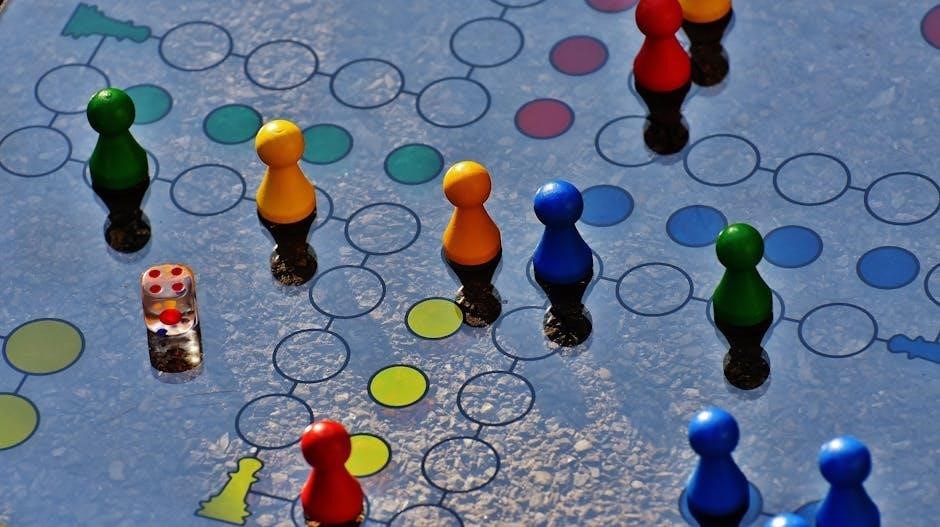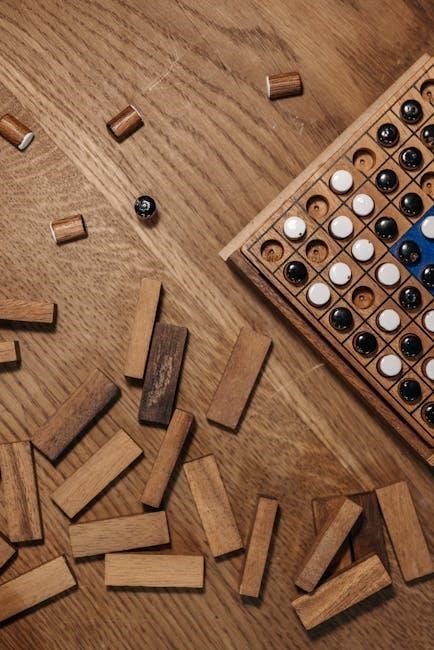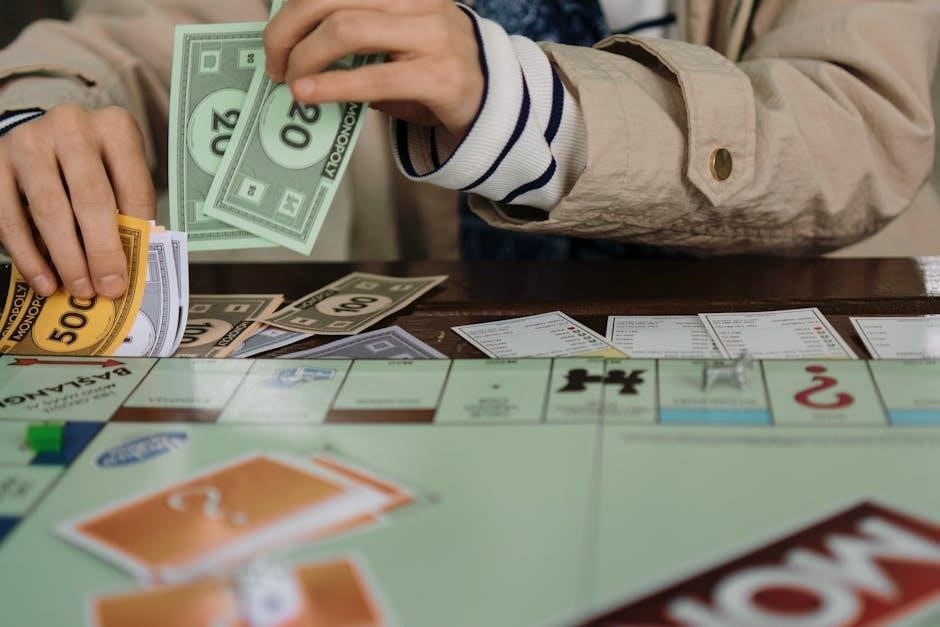Liar’s Dice is a popular dice game combining strategy, probability, and deception. Players bid on dice outcomes, using limited information to outsmart opponents. It’s known for its unpredictability and entertainment value, making it a favorite among gamers seeking both luck and skill-based challenges.
Overview of the Game
Liar’s Dice is a strategic and unpredictable game that combines probability, deception, and skill. Played with dice and cups, it involves players bidding on the number of dice showing specific values. The game requires players to balance truth and bluff, as bids can escalate quickly. Each player starts with a set of dice, and the goal is to guess the number of dice showing a particular number or bluff effectively; The game ends when a challenge is made, and the dice are revealed to determine the winner. Liar’s Dice is known for its simplicity and depth, making it a favorite among both casual and competitive players.
Popularity and Cultural Significance
Liar’s Dice has gained significant popularity worldwide, becoming a cultural phenomenon in gaming circles. Its unique blend of strategy and deception appeals to a wide audience, from casual players to competitive enthusiasts. The game’s simplicity allows it to be played anywhere, making it a staple at social gatherings and events. Additionally, its inclusion in popular media, such as movies and books, has further boosted its recognition. Liar’s Dice is often seen as a test of both mathematical acumen and psychological insight, making it a beloved game with enduring appeal across generations and cultures. Its cultural impact continues to grow as new players discover its charm.

Basic Rules of Liar’s Dice
Liars Dice involves strategic bidding and deception. Each player uses five dice, making bids based on dice numbers. Players can challenge bids, revealing dice to determine the truth.
Number of Dice and Equipment Needed
Liars Dice requires 10 dice in total, with each player using 5 dice and a dice cup. Players also need a flat surface for rolling and a way to keep dice hidden. Cups are essential for concealing dice during rolls, ensuring fairness and suspense. Additional dice may be used for initial roll-offs to determine the first bidder. The game is typically played with two players, each managing their own set of 5 dice. The equipment is straightforward, making the game accessible and easy to set up for quick, engaging matches.
Objective of the Game
The objective of Liar’s Dice is to make accurate bids on the number of dice showing a specific value, while misleading opponents about your own dice. Players aim to outwit each other by guessing or bluffing about the total count of dice faces. The goal is to be the last player remaining by either making correct bids or successfully challenging opponents’ false claims. Winning requires a mix of luck, probability skills, and strategic deception. The game ends when one player is eliminated, often due to incorrect bids or failed challenges, making it a thrilling test of wits and chance.
Setup and Initial Roll
The game begins with each player receiving a set of dice and a cup. All players roll their dice simultaneously. The first bidder is determined by a roll-off, with the highest number going first, ensuring a fair and random start to the competition.
Preparation and Distribution of Dice
Preparation involves ensuring each player has an equal number of dice and a cup for concealment. Typically, each player uses five dice, though variations exist. The dice are distributed evenly, and players are instructed to keep their dice hidden from others. Cups are essential for maintaining secrecy, preventing opponents from seeing the dice during rolls. Before the game starts, all players roll their dice simultaneously, setting the stage for the initial bidding phase. This uniform distribution ensures fairness and maintains the game’s integrity, keeping all participants on equal footing from the outset.
The First Roll and Determining the First Bidder
The game begins with a preliminary roll to determine the first bidder. Each player rolls one die, and the highest number rolled decides who starts. In case of a tie, players re-roll until a clear winner emerges. This initial roll ensures randomness and fairness, preventing any player from having an unfair advantage. Once the first bidder is established, the game proceeds with the bidding phase, where players take turns making bids based on their rolled dice. This setup ensures a balanced and exciting start to the game, keeping all players engaged from the very beginning.

The Bidding Process
The bidding process involves players taking turns to guess the number of dice showing a specific value. Each bid must be higher than the previous one, and players can challenge by calling “liar” if they doubt the bid’s accuracy. The challenge reveals the dice, determining if the bid was truthful or a bluff. This strategic exchange of bids and challenges forms the core of the game, requiring skill and intuition to outwit opponents effectively while managing risk.

How to Make a Bid
To make a bid, players announce the number of dice showing a specific value, such as “three 4s.” The first bidder must start with at least two of a number. Subsequent bids must increase either the number of dice or the dice value. Players can also choose to raise the bid by increasing both. The bid must be plausible based on the dice rolled, and players must avoid overestimating to avoid being called out. Making a bid requires balancing risk and strategy, as an incorrect bid can lead to losing a die. This process demands careful observation of the dice and strategic thinking to outmaneuver opponents effectively.
Challenging a Bid
Challenging a bid involves calling “liar” if a player believes the current bid is false. When a challenge is made, all players reveal their dice to verify the bid. If the bid was accurate or exceeded, the challenger loses a die. If the bid was false, the bidder loses a die instead. In some variations, if a bid is spot-on, the challenger may lose a die, while the bidder remains safe. Challenging a bid requires confidence in the inaccuracy of the claim and carries a risk of losing a die. This mechanic ensures players balance boldness with caution, adding excitement and tension to the game.
Probability and Strategy
Liar’s Dice revolves around understanding probability and using strategic thinking. Players analyze dice outcomes and opponents’ behaviors to make informed bids, balancing risk and reward effectively.
Understanding Probability in Liar’s Dice
Understanding probability is crucial in Liar’s Dice, as it involves predicting dice combinations. With five dice, there are 6^5 = 7776 possible outcomes. Players must calculate the likelihood of specific numbers appearing, such as the odds of rolling a certain value. The probability of a particular number decreases as the bid increases, making higher bids riskier. By analyzing the distribution of dice and opponents’ behaviors, players can make informed decisions. Tracking the number of dice showing specific values helps in deducing probabilities. This strategic element separates skilled players from novices, as experience improves the ability to assess risks accurately.
Common Strategies and Tips
Mastering Liar’s Dice requires a blend of probability knowledge and strategic thinking. One key strategy is starting with conservative bids to gauge opponents’ reactions. Observing opponents’ tendencies helps identify patterns, allowing players to bluff or challenge effectively. Maintaining a poker face is essential to avoid revealing your hand. Beginners should focus on understanding dice probabilities to make accurate bids. Experienced players often mix high and low bids to keep opponents guessing. Another tip is to pay attention to the number of dice showing specific values, as this can influence future bids. Balancing risk and caution is vital for long-term success in the game.

Special Rules and Variations
Liar’s Dice includes variations like spot-on bids, where exact counts escalate stakes, and rules preventing decreases in dice numbers or pips during bidding, adding strategic depth.
Spot-On Bids and Their Consequences
A spot-on bid occurs when a player accurately guesses the exact number of dice showing a specific face value. If a bidder is spot-on, the next player may face penalties, such as losing a die, increasing the challenge. This rule adds strategic depth and risk, as precise bids can shift the game’s momentum. Players must weigh the odds carefully to avoid severe consequences, making spot-on bids a high-stakes yet thrilling element of Liar’s Dice.
Increasing the Bid: Rules and Restrictions
In Liar’s Dice, players can increase the bid by upping the number of dice or the face value, but not both. The first bidder must start with at least two dice of a chosen number. Subsequent bids must exceed the previous in either quantity or value. A player cannot decrease the bid in any way. If a bid is challenged and proven false, the bidder loses a die, adding pressure to make accurate bids. This rule ensures strategic progression, as players must balance risk and confidence when raising the stakes.
Liar’s Dice is a captivating game blending strategy, probability, and deception. Mastery requires practice, making it a fun and intellectually stimulating experience for players of all skill levels.
Liar’s Dice involves 5 dice per player, with bids based on dice values and quantities. Players alternate raising bids, combining numbers and pips, with challenges revealing outcomes. Winning requires balancing probability and deception, as players must avoid being caught lying while outbidding opponents. The game ends when a challenge is accepted, with the loser losing a die. Strategies include understanding probability, managing risks, and reading opponents. Mastery involves practice and adaptability, making it a game of skill and chance. The rules promote engaging gameplay, fostering critical thinking and entertainment for players of all levels.
Final Thoughts on Mastering Liar’s Dice
Mastering Liar’s Dice requires a blend of strategic thinking, probability understanding, and emotional control. Players must balance bold bids with cautious decisions, avoiding overconfidence. Experienced players often start with conservative bids, gradually increasing as they assess opponents’ behaviors. Understanding probability helps in making informed bets, while adaptability allows players to pivot based on game dynamics. Emotional discipline is crucial to avoid falling for bluffs or making impulsive challenges. Practice is key, as it refines intuition and decision-making. Ultimately, Liar’s Dice rewards those who combine analytical skills with psychological insight, making it a challenging yet rewarding game for players of all skill levels.
